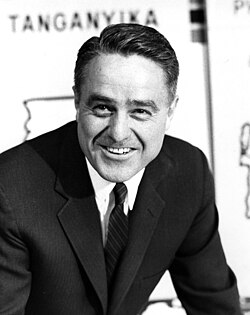
Back سارجنت شرايفر Arabic سارجنت شرايفر ARZ سارجنت شرایور AZB Sargent Shriver Czech Sargent Shriver Welsh Sargent Shriver Danish Sargent Shriver German Sargent Shriver English Sargent Shriver Spanish سارجنت شرایور Persian
Sargent Shriver | |
|---|---|
 Shriver in 1961 | |
| 21st United States Ambassador to France | |
| In office April 22, 1968 – March 25, 1970 | |
| Nominated by | Lyndon B. Johnson |
| Preceded by | Charles E. Bohlen |
| Succeeded by | Arthur K. Watson |
| 1st Director of the OEO | |
| In office October 17, 1964[1] – March 22, 1968[1] | |
| President | Lyndon B. Johnson |
| Preceded by | Office Created |
| Succeeded by | Bertrand Harding |
| 1st Director of the Peace Corps | |
| In office March 22, 1961 – February 28, 1966[2] | |
| President | John F. Kennedy Lyndon B. Johnson |
| Preceded by | Office Created |
| Succeeded by | Jack Vaughn |
| Personal details | |
| Born | Robert Sargent Shriver, Jr. November 9, 1915 Westminster, Maryland, U.S. |
| Died | January 18, 2011 (aged 95) Bethesda, Maryland, U.S. |
| Nationality | American |
| Political party | Democratic |
| Spouse(s) | Eunice Kennedy Shriver (m. 1953–2009, her death) |
| Relations | Arnold Schwarzenegger (son-in-law) |
| Children | Robert Sargent Shriver III Maria Owings Shriver Timothy Perry Shriver Mark Kennedy Shriver Anthony Paul Kennedy Shriver |
| Parents | Robert Sargent Shriver, Sr. and Hilda Shriver |
| Alma mater | Yale University Yale Law School |
| Profession | Attorney |
| Awards | World War II Victory Medal, Purple Heart, Asiatic-Pacific Campaign Medal[3] |
| Signature | |
| Military service | |
| Allegiance | United States of America |
| Branch/service | United States Navy |
| Years of service | 1941–1945 |
| Rank | Lieutenant |
| Battles/wars | World War II |
Robert Sargent Shriver, Jr. (November 9, 1915 – January 18, 2011) was an American politician who was the first director of the Peace Corps from 1961 until 1966, then he was the first director of the OEO from 1964 until 1968, and was the 21st ambassador to France from 1968 until 1970.
He was also a Vice President nominee with presidential nominee George McGovern in 1972, they lost to Richard Nixon and to Spiro Agnew. He was also an activist.
- ↑ 1.0 1.1 capsolano.org/cap_general_info/caa_history.pdf
- ↑ Past Directors Archived 2010-05-27 at the Wayback Machine.
- ↑ Herbert, Bob (April 23, 2004). "A Muscular Idealism". The New York Times. Retrieved December 5, 2008.